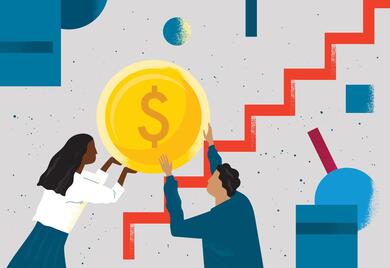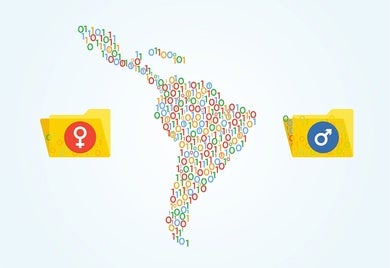
Why Our Region Needs More Gender Bonds
Latin America is not yet late to join the nascent gender bond market. The timing is just right. These bonds also empower women economically and socially without sacrificing profitability.

Empower women and investors will follow
Gender equality is no longer a choice for companies. It is not only about fairness, but about business success. For investors, this has become so clear that one of the world’s largest asset managers has just placed a statue of a defiant girl in front of Wall Street’s iconic bull in New York City to remind businesses that the time to fight for gender equality is now. Why? Because investors have realized that companies that foster diversity yield higher returns. More diversity improves decision-making, reputation, productivity, and employee retention and satisfaction, whTry ich in turn leads to higher returns. Companies with more diverse workforces are also better equipped to innovate in product development, tapping into new business opportunities, such as the women’s market. Investors are looking for results on gender equality But how can companies take concrete actions in line with what investors expect? The answer is not easy, as it requires looking at your company through a completely different lens. Statements and mere commitments to gender equality are not enough. In today’s data-driven world, investors are looking for information to evaluate companies’ performance and their environmental and social footprint. In the past few years, several gender equality indexes have emerged to help investors make informed decisions. Examples include the Barclays Women in Leadership Total Return Index, Pax Ellevate Global Women’s Leadership Index and the Bloomberg’s Financial Services Gender-Equality Index, among others. These benchmarks are tracking gender outcomes, including equal compensation and the number of women in leadership positions, employee policies, ability to create products and services for women, and community engagement. Some of these indexes have investment products to capture the benefits of gender diversity. Since 2014, both Barclays’ Women in Leadership Exchange Trade Notes and Pax Ellevate’s Global Women’s Index Fund enable investors to allocate capital in companies with strong female leadership. As investors’ appetite grow, similar initiatives are under way. Last year SSGA and California State Teachers Retirement System, the second-largest public pension fund in the US, launched the SPDR SSGA Gender Diversity Index ETF (SHE) to invest in companies with high levels of diversity on their boards. With over $280 million in assets, Berkshire Hathaway Inc and Oracle Corp. are among its top investors. A free tool to evaluate gender equality For those willing to roll up their sleeves and move beyond good intentions, the first step is knowing where you are and what you are doing. With this goal in mind, IDB Invest (formerly known as Inter-American Investment Corporation) and the Multilateral Investment Fund, along with UN Global Compact, UN Women and other public and private partners, have created a tool to help companies assess their gender equality performance. The tool follows the UN Women’s Empowerment Principles (WEPs) to unleash the potential of women in the workplace, marketplace and the community. The assessment is free and confidential and can be done by any company from any sector in any country. It looks at corporate policies in place and evaluates the extent to which firms provide equal opportunities, adequate work life balance, support to gender equality in the supply chain and respect to women’s rights in local communities. The tool has far-reaching potential for companies. Designed with the feedback of nearly 200 companies worldwide, the tool has proven to be eye opening for the firms that participated in the pilot phase. Some found that the assessment made them rethink their approach to gender equality in procurement and marketing, while others said it compelled senior management to improve processes. Others highlighted that the tool provided a road map to better integrate gender initiatives into the broader company’s strategy. So, if you are ready to face the bull and reap the benefits, complete the assessment and take action. Investors are waiting. This article was originally published on The Huffington Post Subscribe to receive more content like this! [mc4wp_form]

How to mainstream impact investing?
We have consensus that Impact Investing is a fast growing field attracting a lot of attention. The Monitor Group estimates it could grow to $500 billion in the next 10 years, whereas others estimate this figure in the trillions. However, we still lack consensus on what exactly Impact Investing is and what is needed to bring it mainstream. In Tuesday’s Inter-American Development Bank (IDB) and GIIN Forum on Impact Investing in Latin America and the Caribbean, GIIN's CEO Luther Ragin defined Impact Investing as an investment made by an investor with the express intention of 1) achieving positive social and/or environmental benefits and 2) earning a rate of return.

Financial Institutions: Closing Gender Gaps in the Region
Opening doors for women inside and outside of financial institutions is quickly becoming two sides of the same coin. Setting aside budgets and prejudices is the next step for creating leadership and management opportunities for women in Latin America and the Caribbean.

How Can More Women Business Owners Be Incorporated In Value Chains?
When discussing value chains and gender, we are talking about an environment in which women-owned provider companies do not have the same access as those led by men. Breaking down this asymmetry would mean a real victory for inclusion and development.

Global Microscope 2019: What Can Decision Makers Learn From It?
The Global Microscope on Financial Inclusion is a wealth of information on Latin America and the Caribbean. It is also an insightful road-map for smart decision-making in the year ahead.